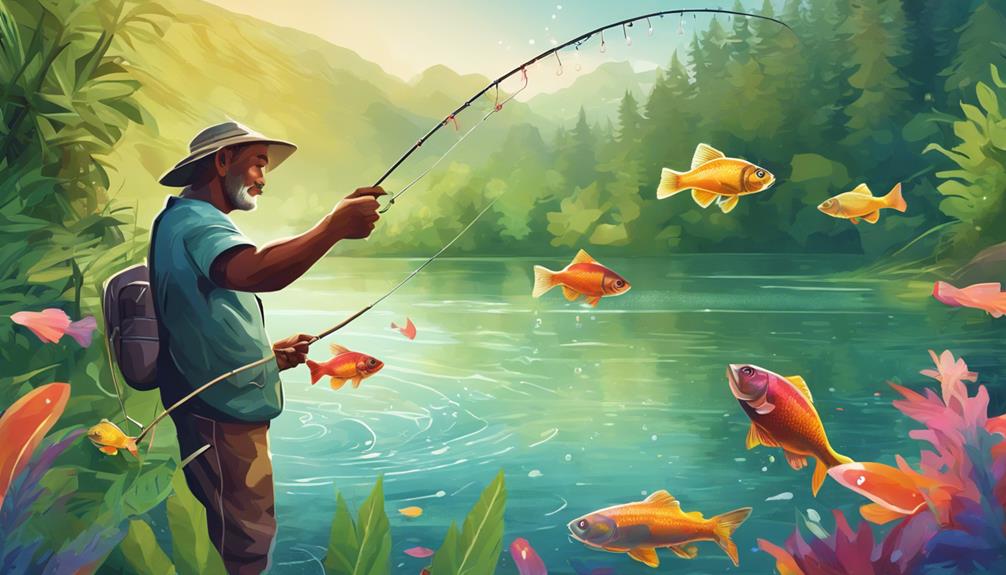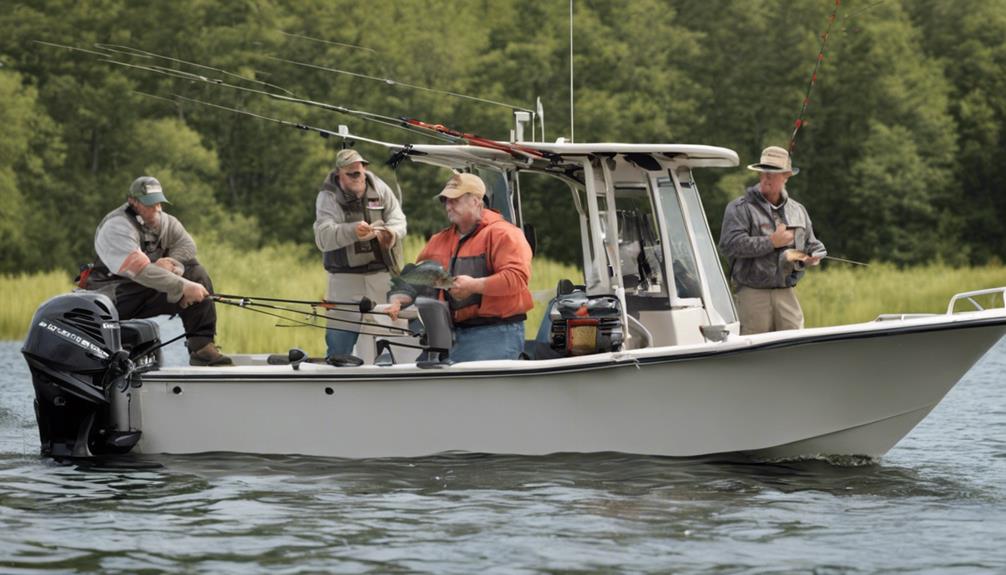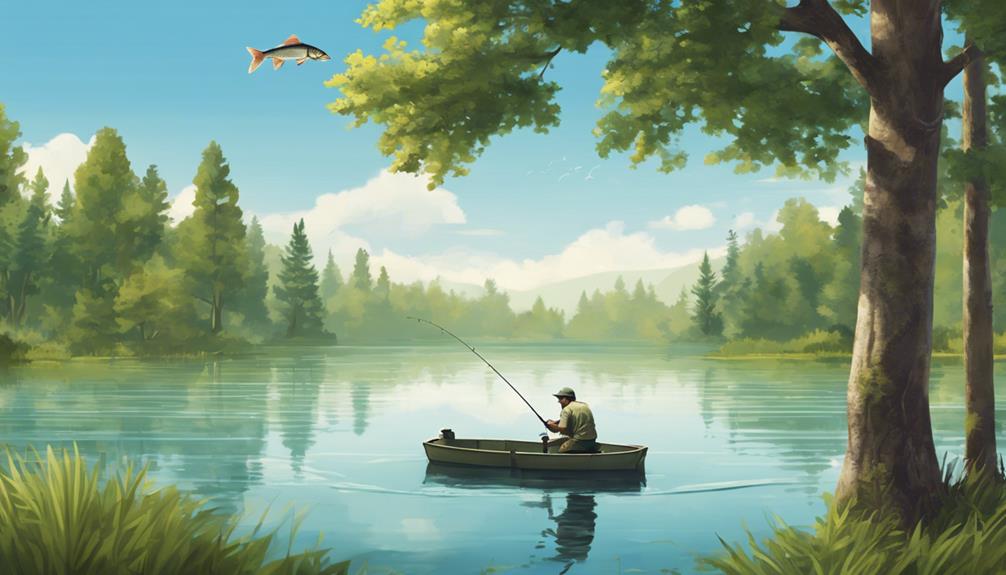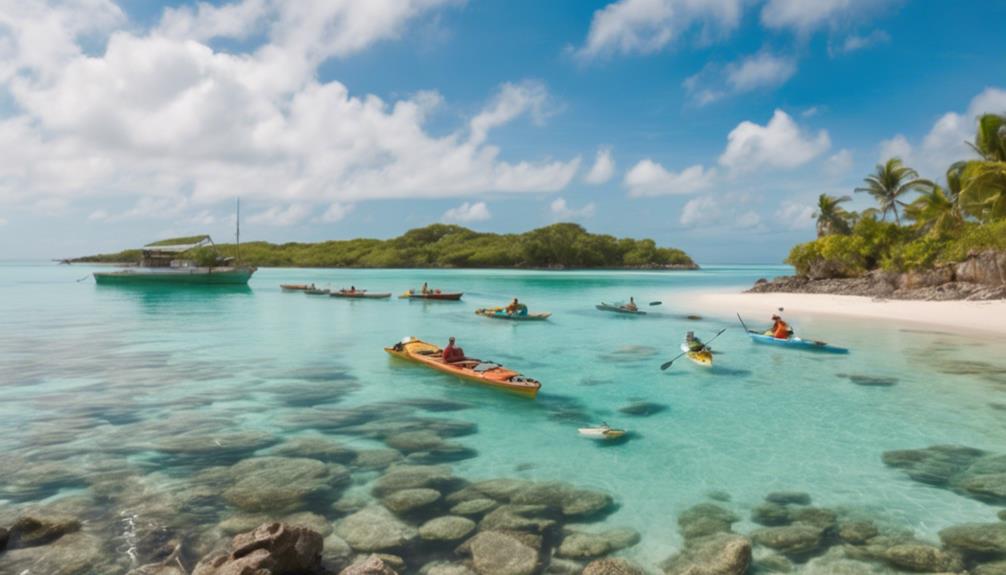So, you think fishing means just casting a line and reeling in a catch? Think again. There's a whole world of biodiversity-friendly fishing practices waiting to be explored. From choosing the right gear to supporting sustainable fishing methods, these tips can make a real difference in preserving marine ecosystems.
But what are the other five strategies that can help you become a more responsible angler and contribute to the conservation of our oceans? Stay tuned to uncover the remaining secrets to fishing in harmony with nature.
Selecting the Right Gear
When choosing fishing gear, opt for sustainable options that minimize harm to marine ecosystems. Select gear made from eco-friendly materials and avoid gear that can cause damage to marine life. Gear maintenance is crucial to ensure your equipment lasts longer and functions properly. Regularly clean your gear after each use to prevent the buildup of dirt and salt that can deteriorate its quality. Proper maintenance not only extends the lifespan of your gear but also reduces the need for frequent replacements, which can contribute to waste.
Proper disposal of fishing gear is essential to prevent environmental harm. Avoid leaving any gear behind, especially plastic-based items that can take hundreds of years to decompose. When disposing of old gear, consider recycling options if available. Some fishing gear, like monofilament fishing line, can be recycled into other products. By properly disposing of your fishing gear, you can help minimize the amount of waste that ends up in oceans and harming marine life.
Choose gear that's durable and can withstand frequent use to reduce the need for replacements. High-quality gear may be more expensive initially, but it can save you money in the long run by lasting longer. Remember, making environmentally conscious choices when selecting and maintaining your fishing gear is essential in preserving marine ecosystems for future generations.
Practicing Catch and Release
Consider implementing catch and release practices during your fishing outings to promote the conservation of fish populations. By releasing fish back into the water instead of keeping them, you contribute to the sustainability of marine life. This practice offers significant conservation benefits by allowing fish to reproduce and maintain healthy population levels in their natural habitats. Ethical considerations also play a crucial role in catch and release. Respecting the life of the fish by giving them the chance to thrive and fulfill their ecological roles aligns with responsible angling practices.
When practicing catch and release, it's essential to handle the fish with care to maximize their chances of survival after release. Use barbless hooks to reduce injury and stress on the fish during the catch and release process. Avoid keeping the fish out of the water for extended periods and release them gently to minimize harm. Additionally, using proper fishing gear and techniques can help increase the survival rate of released fish.
Avoiding Overfishing Hotspots
To help safeguard marine ecosystems, prioritize avoiding overfishing hotspots when planning your fishing expeditions. Overfishing hotspots are areas where fishing activities have significantly depleted fish populations, leading to imbalances in the marine ecosystem. By steering clear of these hotspots, you can play a crucial role in preserving biodiversity and promoting sustainable fishing practices.
When choosing fishing locations, research areas that have been identified as overfished or at risk of becoming overfished. Avoiding these harmful practices can help prevent further depletion of fish stocks and protect vulnerable species from extinction. Instead, opt for fishing in areas where fish populations are abundant and where sustainable fishing practices are encouraged.
Respecting Fishing Regulations
To ensure the sustainability of marine ecosystems, it's essential to adhere to fishing regulations diligently. Respecting fishing regulations not only helps in conserving fish populations but also contributes to the overall health of the oceans. Understanding boundaries set by these regulations is crucial for maintaining a balance between fishing activities and the preservation of marine biodiversity.
When it comes to respecting fishing regulations, promoting education plays a vital role. Educating yourself and fellow fishers on the importance of these regulations can lead to better compliance and understanding of their significance. By spreading awareness and knowledge about fishing regulations, you contribute to the collective effort of protecting marine ecosystems for future generations.
Key Points:
- Compliance is Key: Adhering to fishing regulations is necessary to prevent overexploitation of fish stocks and protect vulnerable species.
- Respect Marine Protected Areas: Understanding boundaries of marine protected areas ensures that these zones serve their purpose in conserving biodiversity.
- Educate Others: Promoting education within fishing communities fosters a culture of respect for regulations and sustainable fishing practices.
Supporting Sustainable Fishing Practices
Support sustainable fishing practices by implementing efficient gear technology that minimizes bycatch and reduces environmental impact. Eco-friendly sourcing is crucial in ensuring that the methods and materials used in fishing are sustainable and don't harm the marine ecosystem. By choosing gear made from recycled materials or using eco-friendly alternatives, you can significantly reduce the environmental footprint of fishing activities.
Conservation partnerships play a vital role in promoting sustainable fishing practices. Collaborating with organizations and other stakeholders dedicated to marine conservation can help implement regulations and initiatives that protect marine habitats and species. By supporting and participating in these partnerships, you contribute to the preservation of biodiversity in our oceans.
Ethical consumption is another key aspect of supporting sustainable fishing practices. By being mindful of where your seafood comes from and how it's caught, you can make informed choices that align with sustainable fishing principles. Choosing seafood from certified sustainable sources and avoiding products associated with destructive fishing practices can help reduce the demand for unsustainable fishing methods.
Habitat preservation is essential for maintaining healthy fish populations and biodiversity. By protecting and restoring critical marine habitats such as coral reefs, mangroves, and seagrass beds, you contribute to the overall health of marine ecosystems. Supporting initiatives that focus on habitat preservation ensures a sustainable future for both fish stocks and the environment.
Minimizing Bycatch
Efficient gear technology that minimizes bycatch is crucial in promoting biodiversity-friendly fishing practices. Bycatch refers to the unintentional capture of non-target species while fishing. This can have detrimental effects on marine ecosystems and biodiversity. To address this issue, here are some key strategies for minimizing bycatch:
- Implementing Selective Gear: Using gear that targets specific species can greatly reduce bycatch. Selective gear such as circle hooks or fish traps can help avoid catching non-target species.
- Using Turtle Excluder Devices (TEDs): TEDs are crucial tools for reducing bycatch of sea turtles in fishing operations. These devices allow turtles to escape from nets, lowering the chances of incidental capture.
- Adopting Acoustic Deterrent Devices: Acoustic deterrent devices emit sound signals to deter marine mammals from fishing gear. This technology helps in reducing interactions between marine mammals and fishing activities, thus minimizing unintended bycatch.
Reducing discards and implementing effective bycatch mitigation measures not only benefit the environment but also support sustainable fishing practices. By incorporating these strategies into fishing operations, fishers can play a significant role in conserving marine biodiversity and ensuring the long-term health of ocean ecosystems.
Participating in Marine Protected Areas
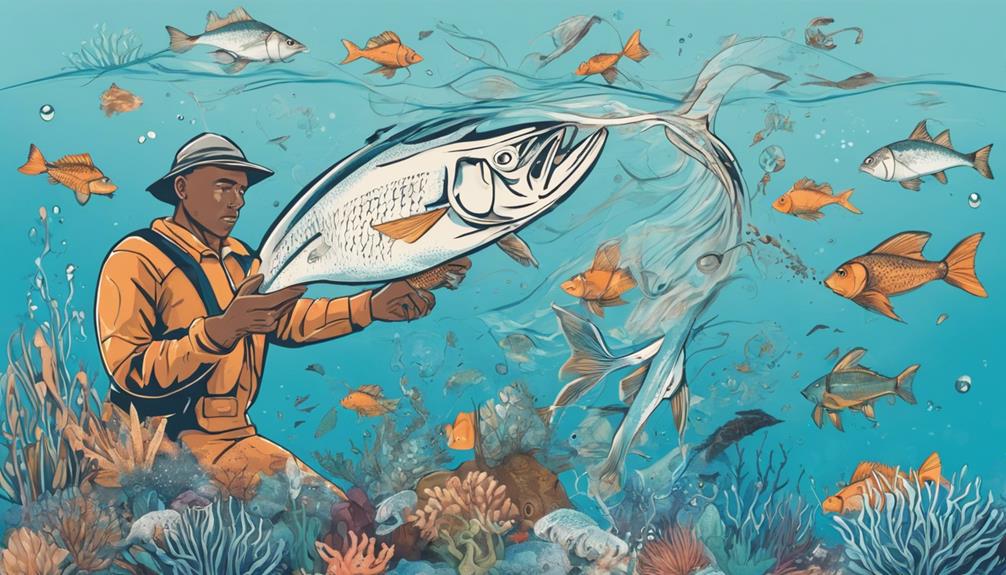
Engage actively in marine protected areas to contribute to the conservation and preservation of marine ecosystems. By participating in these designated zones, you play a crucial role in safeguarding marine biodiversity. Conservation partnerships within marine protected areas allow for collective efforts in monitoring and protecting vulnerable species and habitats. Through ecotourism opportunities, you can experience these unique ecosystems firsthand while supporting their preservation through sustainable tourism practices.
Research collaborations in marine protected areas enable scientists to gather valuable data on marine life and ecosystems, aiding in conservation efforts and better understanding these complex environments. Your involvement in educational initiatives helps raise awareness about the importance of marine conservation and fosters a sense of stewardship among visitors and local communities. By actively engaging in marine protected areas, you contribute to the ongoing protection of marine biodiversity for future generations.
Take advantage of opportunities to volunteer or join guided tours to learn more about marine conservation practices and witness the beauty of these protected areas. Your support and active participation in marine protected areas make a significant difference in ensuring the health and longevity of our oceans. Join forces with conservation organizations, researchers, and local communities to make a positive impact on marine ecosystems.
Engaging in Community Conservation Efforts
To deepen your involvement in marine conservation beyond marine protected areas, consider actively participating in community conservation efforts. Community involvement plays a crucial role in safeguarding marine ecosystems and promoting sustainable fishing practices. By engaging in conservation partnerships with local communities, you not only contribute to the preservation of biodiversity but also foster a sense of collective responsibility towards the environment.
Here are some key ways you can enhance your impact through community conservation efforts:
- Educational Workshops: Organize workshops to raise awareness about the importance of biodiversity conservation and sustainable fishing practices within the community.
- Collaborative Projects: Partner with local organizations and community members to implement conservation projects such as beach clean-ups, habitat restoration, or sustainable fishing initiatives.
- Policy Advocacy: Work together with community leaders and policymakers to advocate for stronger conservation regulations and enforcement measures to protect marine biodiversity.
Frequently Asked Questions
Can Fishing Practices Have a Direct Impact on Biodiversity Conservation?
Fishing practices can directly impact biodiversity conservation. Sustainable harvesting and conservation strategies are crucial to maintain ecosystem balance.
By implementing sustainable management techniques, you can help protect marine life and preserve biodiversity. Your choices as a fisherperson matter in safeguarding the delicate balance of our oceans.
Make informed decisions that support biodiversity conservation for a healthier and more resilient marine environment.
How Can Recreational Anglers Contribute to the Protection of Marine Biodiversity?
To contribute to the protection of marine biodiversity as a recreational angler, community engagement is key. By spreading awareness and educating others about sustainable practices, you can make a significant impact.
Choosing to fish responsibly, respecting catch limits, and properly disposing of waste are all ways you can help preserve marine ecosystems. Your actions matter, and together, recreational anglers can play a vital role in safeguarding the diversity of marine life.
Are There Specific Fishing Techniques That Are More Harmful to Marine Ecosystems Than Others?
When it comes to the impact on marine ecosystems, some fishing techniques can be more harmful than others. Overfishing consequences can devastate populations and disrupt the balance of marine life.
Additionally, gear selectivity impact can lead to unintended bycatch and harm to non-target species. Being aware of these factors and choosing sustainable fishing practices can help minimize the negative effects on marine biodiversity.
What Role Do Commercial Fisheries Play in Biodiversity Conservation Efforts?
Commercial fisheries play a crucial role in biodiversity conservation efforts. By implementing sustainable practices and regulations, these industries can help protect marine ecosystems and species. However, overfishing and destructive fishing methods can harm biodiversity. It's crucial for commercial fisheries to prioritize conservation and adopt biodiversity-friendly fishing practices to ensure the long-term health of our oceans and marine life.
How Can Consumers Support Biodiversity-Friendly Fishing Practices Through Their Purchasing Decisions?
When it comes to sustainable seafood, your choices matter. By raising consumer awareness and demanding ethical fishing practices, you can support biodiversity-friendly fishing. Your purchasing decisions create market demand for sustainable options, encouraging the fishing industry to prioritize environmental conservation.
Stay informed about where your seafood comes from and opt for products that promote biodiversity protection. Your actions as a consumer can make a significant impact on fisheries and marine ecosystems.
Conclusion
By following these biodiversity-friendly fishing practices, you can help protect marine ecosystems and ensure the sustainability of fish populations for future generations.
Remember to always select the right gear, practice catch and release, avoid overfishing hotspots, respect regulations, support sustainable practices, minimize bycatch, participate in marine protected areas, and engage in community conservation efforts.
Your actions can make a difference in preserving our oceans and their diverse wildlife. Keep fishing responsibly!
